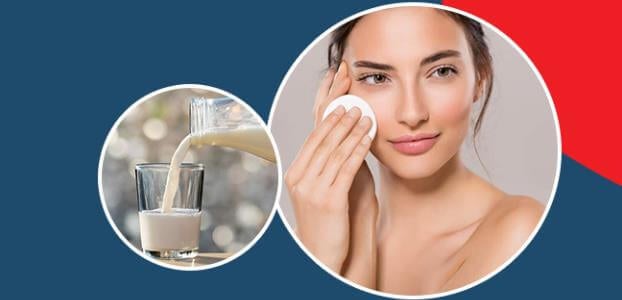
During your childhood, your mother likely chased you around just to ensure you finished a glass of milk each day. Now, the tables have turned, and it's your responsibility to seek out that nourishing milk. Consuming processed or cooked milk can significantly benefit your body due to its wealth of proteins, carbohydrates, calcium, vitamin D, and phosphorus.
These essential nutrients play a crucial role in fortifying bones and enhancing overall body strength. Yet, are you aware that milk also contains vitamins and acids that are incredibly advantageous for your skin? It’s important to note that raw milk generally has a higher concentration of these nutrients, as cooking can diminish their levels.
Historically, women have employed milk to enhance their skin's radiance. In today's world, milk has become a critical component in numerous skincare products. Furthermore, raw milk can be utilized directly in a variety of DIY skincare treatments. In this article, we will explore the uses, benefits, and possible side effects of applying raw milk to your face.
Understanding Raw Milk
Raw milk
According to a study on the Effects of Heat Treatment on Milk, the chemical composition of milk undergoes significant changes when processed. (1) Consequently, raw milk remains rich in proteins, lactulose, vitamin B6, vitamin B12, folic acid, niacin, lactic acid, and numerous other nutrients.
While heating milk makes it safer for consumption—since some individuals may experience nausea or diarrhea from drinking raw milk—raw milk is ideal for external application on the skin.
How to Apply Raw Milk to Your Face

1. Raw Milk as a Facial Cleanser
As a facial cleanser, raw milk excels because it does not strip away essential oils and natural moisture from your skin. Instead, it gently eliminates impurities, dust, dirt, and excess oil embedded deep within the skin.
You can use raw milk on its own as a facial cleanser or enhance its effects by adding turmeric to help even out your skin tone.
2. Milk as a Natural Exfoliator
Thanks to its lactic acid content, milk serves as an outstanding natural exfoliator. To utilize milk for exfoliation, simply combine it with any exfoliating agent of your choice, such as gram flour, papaya puree, rice powder, or activated charcoal.
After blending the ingredients, gently massage the mixture onto your skin to slough off dead skin cells and encourage the regeneration of fresh cells.
3. Milk as a Toner
When combined with rose water, milk acts as an effective toner that helps to even out skin tone, brighten complexion, moisturize the skin, and enhance the elasticity of facial muscles. You can apply this toner as desired, even leaving it on overnight for added benefits.
For extra freshness, consider adding a few drops of lemon juice to your homemade toner.
4. Milk Masks
There are countless facial masks that can be crafted using milk. For instance, a tomato and milk mask can help remove tanning, while a milk and honey mixture provides excellent hydration. Additionally, a blend of milk and rice flour can create a glossy effect, and a milk and yogurt mask can enhance skin radiance.
For best results, mix equal parts of both ingredients, apply the mask for 15-20 minutes, and rinse your face with lukewarm to normal water.
Advantages of Raw Milk for Facial Care

1. Prevention and Treatment of Acne
While consuming milk and dairy products may worsen breakouts for those with acne-prone skin, applying raw milk can actually assist in treating acne due to its lactic acid content. Lactic acid effectively cleanses the skin of impurities and dead skin cells that often clog pores and lead to acne.
A study on the effects of Lactic Acid on skin indicates that lactic acid can reduce acne severity by 90% or more. (2)
2. Brightening of Skin Tone
In addition to lactic acid, raw milk contains vitamin B12 and minerals such as magnesium, which naturally brighten the skin tone. The cumulative effects of reduced acne, improved skin elasticity, de-tanning, and moisturization contribute to a more luminous and supple appearance.
3. Anti-Aging Properties
Raw milk is rich in vitamin D, calcium, and iron. While iron reinforces the skin barrier to combat free radicals responsible for premature aging, vitamin D and calcium stimulate collagen production, enhancing the skin's elasticity and firmness, resulting in a more youthful appearance.
A study illustrates the relationship between calcium and the aging process. (3)
4. Addressing Hyperpigmentation and Tanning
Raw milk contains powerful skin-whitening agents, particularly lactic acid, which helps combat tanning. Additionally, acne scars and blemishes are often major contributors to hyperpigmented spots.
The vitamin A found in milk promotes the production of keratin proteins and stimulates the regeneration of new skin cells while eliminating older cells, thereby helping to treat hyperpigmentation. For further reading, you can explore the role of vitamin A in acne management. (4)
5. Moisturizing Benefits
Raw milk is packed with polyunsaturated and monounsaturated fats that hydrate the skin, making it feel as soft as a baby's. A study on skincare and fats explains how these unsaturated fats can keep skin hydrated and plump. (5)
Moreover, the vitamins and minerals present in milk aid in moisturizing the skin and regulating oil production, making it a fantastic organic, lightweight alternative to conventional moisturizers.
6. Relief from Sunburn, Redness, and Inflammation
Known for its soothing properties, cold raw milk can provide immediate relief from sunburns, irritation, skin redness, and inflammation when applied topically. Additionally, milk is rich in antioxidants, which help counteract skin damage caused by sun exposure, free radicals, or unhealthy lifestyles.
Research on Milk Proteins and Their Uses in Cosmetology shows how milk can aid in treating sunburns, ulcers, and scars. (6) However, it is essential to note that






































